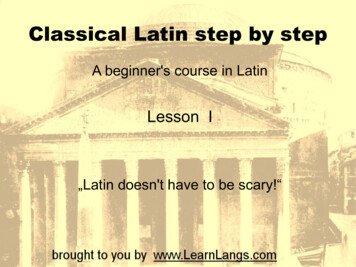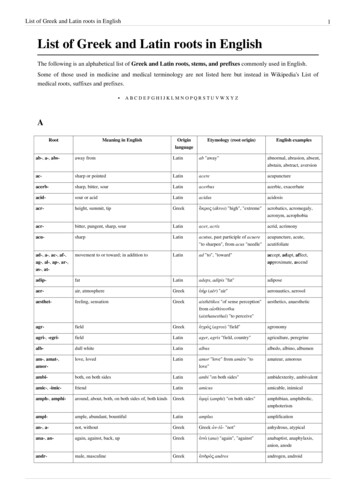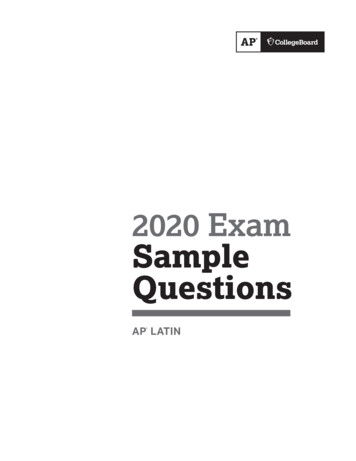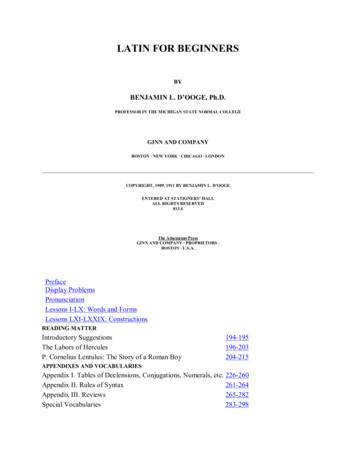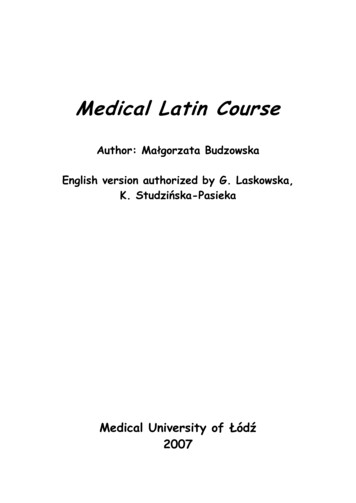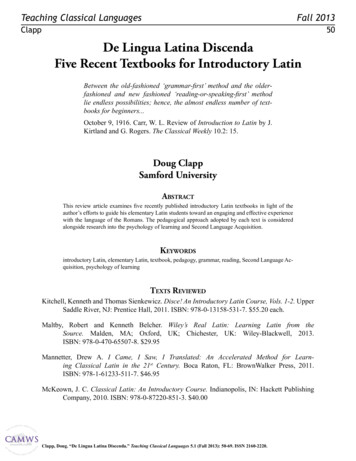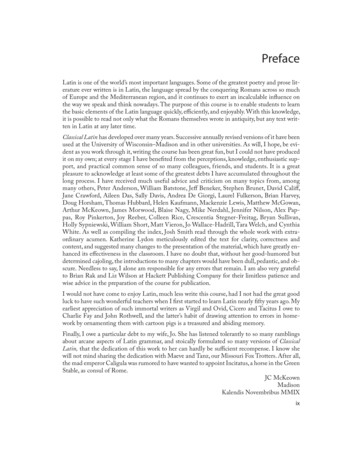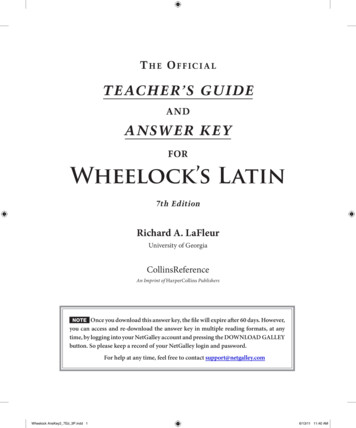
Transcription
Thh e O f f icTiciiaallTEEACHACH E R’S GUTGUIIDEDEaNDANDANSWNSW EAERRKKEYEYforforWheelock’s LatinWheelock’sLatin6th Edition, Revised7th EditionRichardA. LaFleurLaFleurRichard A.Universityof GeorgiaGeorgiaUniversity printImprint of HarperCollinsHarperCollins PublishersOnce you download this answer key, the file will expire after 60 days. However,you can access and re-download the answer key in multiple reading formats, at anytime, by logging into your NetGalley account and pressing the DOWNLOAD GALLEYbutton. So please keep a record of your NetGalley login and password.NOTEFor help at any time, feel free to contact support@netgalley.comWheelock AnsKey2 7Ed 3P.indd 16/13/11 11:40 AM
All contents copyright 2011, by R. A. LaFleurAll rights reserved. Printed in the United States of America. No part of this book may be usedor reproduced in any manner whatsoever without written permission. For information, addressHarperCollins Publishers, Inc., 10 East 53rd Street, New York, New York 10022.IMPORTANT NOTICES: Duplication, copying, or online posting ofthis guide is a violation of copyright. If you are a student currentlyenrolled in any Latin class that assigns readings and translations inWheelock for homework and/or credit and have somehow improperlygained access to this key, such access is strictly prohibited and likelyconstitutes a violation of your school’s academic-honesty policies.Rev. 5-25-11Wheelock AnsKey2 7Ed 3P.indd 26/13/11 11:40 AM
“He studied Latin like the violin, because he liked it.”From Robert Frost’s “ The Death of the Hired Man”IMPORTANT NOTICES: Duplication, copying, or online posting of this guide is aviolation of copyright. If you are a student currently enrolled in any Latin class thatassigns readings and translations in Wheelock for homework and/or credit and havesomehow improperly gained access to this key, such access is strictly prohibited andlikely constitutes a violation of your school’s academic-honesty policies.Wheelock AnsKey2 7Ed 3P.indd 36/13/11 11:40 AM
Wheelock AnsKey2 7Ed 3P.indd 46/13/11 11:40 AM
Teaching Wheelock’s LatinThe seventh edition of Wheelock’s Latin, published in 2011, features a great many revisionsintended to make this classic textbook even more effective, more interesting, and more user‑friendly for both teachers and learners. Following is an overview of the changes: The text was entirely re‑keyed, providing the opportunity for formatting and designchanges that help clarify each CAPVT’s organization and, along with new photographsand drawings, make the book more visually appealing. SMALL BOLD CAPITALS are employed to call attention to important new grammaticaland other technical terms. To encourage more active use of the language in the classroom, Latin is employed in theCAPVT titles and for section heads (Exercitationes instead of “Practice and Review,”Vocabula for “Vocabulary,” etc.). Material in the footnotes has either been incorporated into the text or deleted. The maps have been updated, and more frequent references appear in the text toencourage their use. Significant revisions have been made in each CAPVT’s grammar discussion section(newly titled Grammatica), including systematic introduction and definition of allparts of speech, earlier introduction of verb synopsis, and clarification of numerousgrammatical points. The CAPVT Vocabula have been revised in several ways, including spelling outfull nominatives for all adjectives, genitives for all nouns, and principal parts for allverbs, even regular first conjugation verbs–thus eliminating abbreviations potentiallydistracting to students trying to learn new vocabulary items for the first time. Eachlist is preceded by a brief discussion of new or exceptional types of words that will beencountered, as well as general suggestions on how to master vocabulary. Similarly, each CAPVT’s Lectiones et Translationes (“Readings and Translations”)section opens with a variety of tips aimed at building reading and translating skills.Wheelock AnsKey2 7Ed 3P.indd 56/13/11 11:40 AM
6 Teacher’s Guide and Answer Key for Wheelock’s LatinEnglish derivatives are provided for Latin words glossed in the Sententiae Antiquae andreading passages, as an aid to learning and recalling their meanings. Some of the existing readings have been slightly revised for improved reinforcement ofnew and recent vocabulary and grammar; and a few new authentic readings have beenadded to each CAPVT, in particular a selection of graffiti from Pompeii, titled Scripta inParietibus (“Writings on Walls”), which are accompanied by drawings or photographsand designed to provide interesting insights into the lives, and literacy, of ancient Romanmen and women. The inscriptions and the CAPVT’s literary passages are provided with expandedintroductions and a few Quaestiones, reading comprehension and discussion questionsdesigned to focus the reader’s attention on important points of both subject and style. The Etymologia sections have been in some instances shortened, in other instancesexpanded, particularly with the addition of more Romance language derivatives; andthere are a few changes to the Latina Est Gaudium sections as well. The Index has been expanded. Finally, the website at (www.wheelockslatin.com), this translation key and the onlineteacher’s guide, vocabulary cards, and other ancillaries available from Bolchazy‑ CarducciPublishers (www.bolchazy.com) have been updated to reflect changes to the textbook.Some Strategies for the Teacher The Lectiones et Translationes in this new, expanded edition purposely provide morematerial for reading and translation than one would want to require for homework inthe two or three days typically allotted to a CAPVT in a semester course or the week orso allotted in high school. Instructors are encouraged to be selective: my suggestion isto assign study of the new grammar, paradigms, and vocabulary for the first day or two,requiring for written homework only limited selections from the Exercitationes andSententiae Antiquae, and reserving the others (or some of the others, carefully selectedin advance) for in‑class sight translation; assignments for the second or third day shouldinclude the reading passages and graffiti following the Sententiae Antiquae, whichwill give students the experience they need with continuous narrative. I like to assignone or two of the English‑to‑Latin Exercitationes each day, or will sometimes dividethe students into small groups, giving them five minutes or so to work on one of thesentences together and having a member of each group put their sentence on the boardWheelock AnsKey2 7Ed 3P.indd 66/13/11 11:40 AM
Teacher’s Guide and Answer Key for Wheelock’s Latin 7for review. Students should regularly be encouraged to practice new material at homewith the Self‑Tutorial Exercises located at the back of the book, checking their accuracywith the answer key that follows, and sentences from these exercises, again pre‑ selectedfor the purpose, can be used to drill mastery of new concepts via sight translation inclass. The companion reader Scribblers, Scvlptors, and Scribes provides a broad array of entirelyauthentic, unadapted classical Latin texts whose vocabulary and grammar are correlatedwith the the CAPVTs of Wheelock’s Latin. These readings, including a wide range ofgraffiti and other inscriptions, proverbs, and literary texts, provide insights into not justthe minds of Rome’s movers and shakers, her politicians and generals, philosophers andpoets, but also into the daily lives of the average Roman. Students should be assigned aselection from these readings at least for their final day on each CAPVT. Most instructors will also want their students to use the Workbook for Wheelock’s Latin, which contains a variety of additional exercises, including for each CAPVT adetailed set of Intellegenda (learner INTELLEGENDA–also included in this guide),a series of questions designed to focus directly on the newly introduced grammar, avariety of transformation drills, word, phrase, and sentence translations, questionson etymologies, synonyms, antonyms, and analogies for new vocabulary items, andreading comprehension questions to test the student’s understanding of the CAPVT’sreading passages. Students may not have time to complete all of the many Workbookitems provided for each CAPVT, but instructors might reasonably require or advisethem at least to review the Intellegenda, answer all the Grammatica questions and thencomplete one or two items from each section of the Exercitationes, all the Vis Verborum(“The Power of Words”) etymology items, one or two of the Latin‑to‑English translationsin section A of the Lectiones (readings), and all the items in Lectiones B (questions onthe CAPVT’s literary passages). There are numerous other materials designed to complement Wheelock’s Latin, theWorkbook for Wheelock’s Latin, and Scribblers, Scvlptors, and Scribes, including audioCDs, computer software, vocabulary cards, grammar review cards, and a wealth ofinternet resources, most of which, along with further suggestions on teaching andlearning Latin via Wheelock, are accessible at the official Wheelock’s Latin SeriesWebsite, www.wheelockslatin.com, and described in my book Latin for the 21st Century:From Concept to Classroom (available from Pearson Publishers).Wheelock AnsKey2 7Ed 3P.indd 76/13/11 11:40 AM
8 Teacher’s Guide and Answer Key for Wheelock’s LatinLANGUAGE IS SPEECH:The Importance of Pronunciation and Reading AloudAlthough oral‑aural communication and conversational skills are sometimes–and unfortunately–given little stress in the Latin classroom, nevertheless a reasonably correct and consistentpronunciation is essential to the mastery of Latin, as of any language. An ability to pronouncewords and to read sentences and longer texts aloud according to the few, simple rules provided inWheelock’s introduction also enable your students to “pronounce” correctly in their mind and,as they think of a word, to spell it correctly. Without that ability, learners will confuse not onlythe sounds of the language, but also the spelling and often therefore the meaning of its words.Fortunately, pronuntiatio Latina est facilis, “Latin pronunciation is easy,” far easier thanthat of English or any other language I know. Vowels have only two possible sounds; most con‑sonants have only one; and the rules for accentuation are just that, rules that you can count onevery time. Moreover, nearly every sound that existed in classical Latin occurs also in English(the chief exceptions being the vowel y and the diphthong eu, neither of which was very common,the trilled r, and final ‑m). And in Latin, “what you see is what you get” or rather “what you see iswhat you hear”: there are no “silent e’s” or other such oddities of correlating spelling with soundthat have led to the familiar quip that in English “ghoti” can even be pronounced “fish” (gh‑ asin “enough,” ‑o‑ as in “women,” and ‑ti as in “nation”)!As your students begin their study of Latin, make them constantly aware that it did notmerely consist of written texts to be read mutely from a printed page, but it was for a millenniumand more a spoken language–a language learned and spoken by Roman boys and girls, in fact,just as your students’ own native language was acquired and spoken by them in their childhood;it was a living language read and spoken by average Roman women and men, and not just byfamous orators, poets, and politicians. And–a fact some may find startling–the Romans them‑selves never read silently, but always aloud; they regarded language as speaking and listening, andviewed writing as merely a convenient means of recording communications spoken and heard.In your teaching of this classic and (because of its recurring inflections) highly sonoroustongue, challenge your students to apply all their language learning skills toward acquiring mas‑tery, spending at least a few minutes every day listening and speaking, and not just silently read‑ing and writing. In a classroom setting, you and your students will have abundant opportunityto hear and speak the language; but even so, or if you are studying independently or homeschooling your children with a minimum of background in the language yourself, the Readingsfrom Wheelock’s Latin CDs and the online audio at www.wheelockslatin.com are indispensableWheelock AnsKey2 7Ed 3P.indd 86/13/11 11:40 AM
Teacher’s Guide and Answer Key for Wheelock’s Latin 9resources. Students must always practice and review paradigms and vocabulary items by listen‑ing to and reading them aloud. Most especially, like true Romans, they should read aloud everyLatin sentence or passage they encounter; and, though this book will certainly help your studentsdevelop their skills in translating Latin into English, you should always urge them first to readevery Latin text aloud for comprehension, reading and hearing and thinking what the text is say‑ing, before ever attempting to translate into English.Carpe diem—carpe Latinam!Wheelock AnsKey2 7Ed 3P.indd 96/13/11 11:40 AM
Wheelock AnsKey2 7Ed 3P.indd 106/13/11 11:40 AM
Capvt IINTELLEGENDA (“Objectives”)Upon completion of this CAPVT, students should be able to:1. Define the five principal characteristics of a verb.2. Explain the difference between the factors that mark the person and number of an Englishverb and those that mark a Latin verb.3. Identify the active voice personal endings of a Latin verb.4. Form the present stem of a first or second conjugation verb.5. Recognize, form, and translate the present active infinitive, indicative, and imperative of afirst or second conjugation verb.6. Discuss and apply basic rules of word order and translation of simple Latin sentences.N.B.: macrons are used below only in the English-to-Latin Practice and Review Sentences; macrons for all otherLatin sentences and passages appear in the textbook itself. Parentheses ( ) are used within the English translations forwords that are supplied (other than articles and possessives) as well as for alternate, usually more idiomatic render‑ings; square brackets [ ] indicate words that can be omitted for more natural English idiom. Parentheses in the Latintranslations from English indicate some alternate options.SENTENTIAE (“Sentences”)1. Labor me vocat.Work calls (beckons) me. (Cp. our expression “duty calls.” Beginners are often temptedto translate this sent. “He calls me to work”; simply explain that the phrase “to work” inthis instance would require a prep. (ad), and that the Lat. sent. here exhibits the commonsubj.-obj.-vb./SOV word order. Cp. #10 below.)Wheelock AnsKey2 7Ed 3P.indd 116/13/11 11:40 AM
12 Teacher’s Guide and Answer Key for Wheelock’s Latin2. Mone me, si erro—amabo te!Warn me, please, if I err (make a mistake).3. Festina lente.Hurry up (make haste) slowly. (A favorite, paradoxical saying of Augustus, Rome’s firstemperor, who reigned 31 B.C. to A.D. 14; the Romans were fond of such epigrammaticstatements.)4. Laudas me; culpant me.You praise me; they blame me. (Here the vbs. are positioned first, to emphasize thecontrast; the noun culpa is related to the vb. culpo, and the expression mea culpa, “mymistake,” is one of hundreds of Lat. phrases commonly used in Eng.)5. Saepe peccamus.We often sin (do wrong). (The Eng. diminutive “peccadillo” is related to the vb. andmeans “a minor fault or shortcoming”; advs., like saepe here, usually precede the wordsthey modify.)6. Quid debemus cogitare?What ought we to think? (What should we think?) (Debere is often employed, as here,with an inf.)7. Conservate me!Save me! (The prefix con- often has an intensifying force; here conservate is moreemphatic than servate.)8. Rumor volat.Rumor flies (moves quickly). (Volare gives us “volatile”; sharing with students, or solicitingfrom them, a few derivatives is a useful technique when encountering new vocabulary.)9. Me non amat.He (she) does not love me. (Again, the adv. precedes the vb., which is usually placed at theend of the sent. or clause.)10. Nihil me terret.Nothing terrifies (frightens) me. (SOV; for this typical word order, cp. #1 above.)11. Apollo me saepe servat.Apollo often guards (protects) me. (Apollo was god of the sun and the arts and alsoprotector of shepherds.)Wheelock AnsKey2 7Ed 3P.indd 126/13/11 11:40 AM
Teacher’s Guide and Answer Key for Wheelock’s Latin 1312. Salvete!–quid videtis? Nihil videmus.Hello!–what do you see? We see nothing.13. Saepe nihil cogitas.You often think (about) nothing. (Descartes, the 17th century philosopher, is known forthe maxim cogito ergo sum, “I think, therefore I am.”)14. Bis das, si cito das.You give twice if you give quickly. (A famous Roman proverb meaning that a quickresponse to a person in need is worth twice as much as a slow one; bis is from the sameorigin as the prefix bi- in “bicycle” and cito contains the same root as Eng. “excite” and“incite.” The vb. do is irreg. in that the pres.-stem vowel -a- is long only in the sg. imper.da and the 2nd pers. pres. indic. das.)15. Si vales, valeo.If you are well, I am well (if you’re okay, I’m okay). (As the note in the text points out, thiswas a common salutation in Roman letters, just as vale/valete was often employed at theend of a letter.)16. What does he see?Quid videt? (Lat. uses pron. subjs. only for emphasis; usually, as here, a pronominal subj.is simply expressed in the vb. ending.)17. They are giving nothing.Nihil dant. (Dant nihil is acceptable of course; but in Lat. the vb. usually goes at theend.)18. You ought not to praise me.Mē nōn laudāre dēbēs (or, pl., dēbētis).19. If I err, he often warns me.Sī errō, mē saepe monet.20. If you love me, save me, please!Sī mē amās, servā (cōnservā) mē, amābō tē! (The pl. amātis could be used, but then thepl. imper. (cōn)servāte would also be required, as would pl. vōs, which has not yet beenintroduced.)Wheelock AnsKey2 7Ed 3P.indd 136/13/11 11:40 AM
14 Teacher’s Guide and Answer Key for Wheelock’s LatinTHE POET HORACECONTEMPLATES AN INVITATIONMaecenas et Vergilius me hodie vocant. Quid cogitare debeo? Quid debeo respondere? Sierro, me saepe monent et culpant; si non erro, me laudant. Quid hodie cogitare debeo?Maecenas and Vergil are summoning (inviting) me today. What should I think? (What am I tothink?) What (how) should I respond? If I err (do something wrong), they often admonish me andfind fault with me; if I do not err (do nothing wrong), they praise me. What should I think (expect)today?(Adapted very freely from autobiographical references in Horace’s poetry, as the notes pointout; the literary patron Maecenas and the poet Vergil have invited Horace to meet with thembut without telling him the purpose of the visit. Horace was much concerned with how he wasviewed by others; in the initial stages of his acquaintance with Maecenas and Vergil, he wassomewhat unsure about their relationship. Ask students to answer the comprehension questionson this passage in the Lectiōnēs B section of the Workbook; remember that an answer key to theWorkbook is available to instructors online at www.harperacademic.com. Remind your studentsto listen to Mark Miner’s readings of these Sententiae and the Horace passage on the CD’s in theset Readings from Wheelock’s Latin, available for purchase at www.bolchazy.com.)SCRIPTA IN PARIETIBVSAv e , pu e l l a!Hello, girl!IMPORTANT NOTICES: Duplication, copying, or online posting of this guide is aviolation of copyright. If you are a student currently enrolled in any Latin class thatassigns readings and translations in Wheelock for homework and/or credit and havesomehow improperly gained access to this key, such access is strictly prohibited andlikely constitutes a violation of your school’s academic-honesty policies.Wheelock AnsKey2 7Ed 3P.indd 146/13/11 11:40 AM
CAPVT IIINTELLEGENDA ("Objectives")Upon completion of this CAPVT, students should be able to:1. Name the cases of a Latin noun and identify the basic uses or grammatical functions ofeach case in a sentence.2. Form the base of any noun.3. Recognize, form, and translate first declension nouns and adjectives.4. Explain what is meant by noun and adjective gender.5. State the rules for adjective/noun agreement and verb/subject agreement.6. Describe the usual positioning of an adjective.7. Define the terms “declension” and “syntax.”N.B.: macrons are used below only in the English-to-Latin Practice and Review Sentences; macrons for all otherLatin sentences and passages appear in the textbook itself. Parentheses ( ) are used within the English translations forwords that are supplied (other than articles and possessives) as well as for alternate, usually more idiomatic render‑ings; square brackets [ ] indicate words that can be omitted for more natural English idiom. Parentheses in the Latintranslations from English indicate some alternate options.SENTENTIAE ANTIQUAE (“Ancient Sentences”)1. Salve, O patria!Greetings, O (my) fatherland! (Possessives can, and often should, be supplied—an optionhere.)2. Fama et sententia volant.Wheelock AnsKey2 7Ed 3P.indd 156/13/11 11:40 AM
16 Teacher’s Guide and Answer Key for Wheelock’s LatinRumor and opinion move quickly.3. Da veniam puellae, amabo te.Give pardon to the girl (Pardon the girl), please. (Construing puellae as gen., of the girl,would make far less sense, so dat. is a better option here; routinely supply the articles “a/an/the” wherever appropriate to Eng. idiom.)4. Clementia tua multas vitas servat.Your clemency saves (is saving) many lives. (Note the adj. word order; multas, like otheradjs. denoting number or size, precedes for emphasis.)5. Multam pecuniam deportat.He carries (is carrying) off much (a lot of) money.6. Et fortunam et vitam antiquae patriae saepe laudas sed recusas.You often praise the ancient fatherland’s fortune and (way of) life, but you reject (them)or You often praise but reject the ancient fatherland’s fortune and (way of) life. (Bothnouns are objs. of both vbs.; like an adj., a gen. noun modifies another noun and usuallyfollows it, just as the gen. phrase antiquae patriae here modifies and follows the nounsfortunam and vitam. To “recuse” oneself is to refuse to serve.)7. Me vitare turbam iubes.You order me to avoid the crowd. (Since me precedes the inf., just as a regular nom./subj.ordinarily precedes its vb., it is here subj. of the inf. and turbam is the dir. obj., ratherthan the opposite. Something “inevitable” cannot be avoided.)8. Me philosophiae do.I give (dedicate/devote) myself to philosophy. (Use the reflexive form “-self” when a pron.refers back to the subj.; here again the dat. option makes more sense than the gen.)9. Philosophia est ars vitae.Philosophy is the art of life. (More idiomatic than life’s art.)10. Sanam formam vitae conservate.Maintain (preserve) a healthy (sound) form of life. (Again note that a gen. noun, like anadj., typically follows the noun it describes.)11. Immodica ira creat insaniam.Immoderate (unrestrained) anger creates (produces) insanity. (The vb. is not always placedat the end of its clause; the adj. here precedes its noun, and the dir. obj. closes the sent.,both for emphasis.)Wheelock AnsKey2 7Ed 3P.indd 166/13/11 11:40 AM
Teacher’s Guide and Answer Key for Wheelock’s Latin 1712. Quid cogitas?—debemus iram vitare.What are you thinking?—we ought to (must) avoid anger.13. Nulla avaritia sine poena est.No greed (greedy act/form of greed) is without penalty (goes unpunished). (Many Lat. -tianouns produce nouns ending in “-ce” or “-se” in Eng.; hence avaritia “avarice” andlicentia “license.”14. Me saevis catenis onerat.He oppresses me with cruel chains. (An “onerous” task is an oppressive one.)15. Rotam fortunae non timent.They do not fear the wheel of fortune. (A common metaphor for fate, in both Lat. andEng.; both sense and word order rule against construing fortunae as subj.)16. The girls save the poet’s life.Puellae vītam poētae (cōn)servant.17. Without philosophy we often go astray and pay the penalty.Sine philosophiā saepe errāmus et poenās damus. (Remember the idiom poenas dare:see poena in Ch. 2 Vocab.)18. If your land is strong, nothing terrifies the sailors and you ought to praise your greatfortune.Sī patria tua valet, nihil nautās terret et magnam fortūnam (tuam) laudāre dēbēs.(A Roman would likely omit the adj. tuam, since the reference is rather clearly to thesubj. of the vb. debes.)19. You (pl.) often see the penalty of my anger and warn me.Poenam īrae meae saepe vidētis et mē monētis.20. The ancient gate is large.Porta antīqua est magna.CATULLUS BIDS HIS GIRLFRIEND FAREWELLPuella mea me non amat. Vale, puella! Catullus obdurat: poeta puellam non amat, puellamnōn vocat, formam puellae non laudat, puellae rosas non dat, et puellam non basiat! Ira meaest magna! Obduro, mea puella—sed sine te non valeo.Wheelock AnsKey2 7Ed 3P.indd 176/13/11 11:40 AM
18 Teacher’s Guide and Answer Key for Wheelock’s LatinMy girl does not love me. Farewell (Goodbye), girl! Catullus is tough: the poet does not love the girl,he does not call the girl, he does not praise the girl’s beauty, he does not give roses to the girl (givethe girl roses), and he does not kiss the girl! My anger is great! I am tough, my girl—but without youI am not (doing very) well.(Adapted from a short dramatic poem by Catullus; the girl is Lesbia, a pseudonym for the poet’sreal-life mistress Clodia, wife of the senator Metellus. Discuss the effect of the shift from firstperson [the real world, Catullus’ girlfriend has dropped him], to third person [a fantasy world,where Catullus imagines himself as a tough guy who doesn’t need the girl and can get along justfine without her], back to first person [the fantasy collapses: I may be tough, Catullus confesses,but I can’t live without you]. Note the climactic progression too in the central “fantasy” scenefrom not loving the girl, to not praising her beauty, to not sending her flowers, to not kissingher—poor Catullus, this is where he loses control and lapses back into despondency. Even thesimplest reading passages in this book allow plenty of room for discussion of author, context,content, and style. Remember that every reading passage should be introduced in more or lessthe following way: discuss the author and his works in general terms; read the passage aloud ex‑pressively; ask a few carefully pre-selected comprehension questions, to draw students’ attentionto key content points; have individual students read one or more sentences aloud and translate;correct their mispronunciations sparingly or simply by repeating the word, phrase, or sentencecorrectly; deal with translation errors by asking focused questions on the words in question, andalways help students toward a natural, idiomatic rendering vs. a stiff, stilted version; avoid inter‑rupting the flow of reading, translation, and comprehension by asking grammar questions–dealwith grammar at this point only if the student makes some grammar-based error in translating;after the entire passage hasbeen translated, ask a few discussion questions, such as the one sug‑gested above regarding the shift from first person to third and back to first; make, or ask for, anyfurther comments on the passage’s content and style; read the passage aloud one last time, sostudents can experience it as a whole once they have a fuller understanding of its meaning; andonly finally ask questions on grammar, focusing in particular on material newly introduced inthe current CAPVT, in this instance, e.g., on noun cases and uses, since those are first presentedhere in Ch. 2. Ask students to answer the comprehension questions on these passages in theLectiōnēs B section of the Workbook; remember that an answer key to the Workbook is avail‑able to instructors online at www.harperacademic.com. Remind your students to listen to MarkMiner’s readings of these Sententiae Antīquae and reading passages on the CD’s in the set Readings from Wheelock’s Latin, available for purchase at www.bolchazy.com.)Wheelock AnsKey2 7Ed 3P.indd 186/13/11 11:40 AM
Teacher’s Guide and Answer Key for Wheelock’s Latin 19SCRIPTA IN PARIETIBVSFortuna.Felic u lam amat.Fortune (luck)He loves Felic(u)la.IMPORTANT NOTICES: Duplication, copying, or online posting of this guide is aviolation of copyright. If you are a student currently enrolled in any Latin class thatassigns readings and translations in Wheelock for homework and/or credit and havesomehow improperly gained access to this key, such access is strictly prohibited andlikely constitutes a violation of your school’s academic-honesty policies.Wheelock AnsKey2 7Ed 3P.indd 196/13/11 11:40 AM
CAPVT IIIINTELLEGENDAUpon completion of this CAPVT, students should be able to:1. Recognize, form, and translate second declension masculine nouns and adjectives.2. Define the term “apposition” and state the rule for agreement of two words in apposition.3. Discuss and apply basic rules of Latin word order.EXERCITATIONES1. Filium nautae Romani in agris videmus.We see the Roman sailor’s son (the son of the Roman sailor) in the fields. (Typical wordorder, with gen. noun following the noun it modifies and the prep. phrase preceding thevb.; remember that nauta is m. and thus requires a m. adj.)2. Pueri puellas hodie vocant.The boys are calling (inviting) the girls today.3. Sapientiam amicarum tuarum, O filia mea, semper laudat.(Oh) my daughter, he (she) is always praising your friends’ intelligence. (The interj. O wascommonly used with a voc. noun in Lat., but may be omitted in Eng., where it is lessidiomatic.)4. Multi viri et feminae philosophiam antiquam conservant.Many men and women are preserving (maintaining) the ancient philosophy. (Multus, likeother adjs. of number and size, often precedes its noun; in gender it here agrees with thenearer of the two nouns that it modifies.)Wheelock
Teaching Wheelock’s Latin The seventh edition of Wheelock’s Latin, published in 2011, features a great many revisions intended to make this classic textbook even more effective, more interesting, and more user
